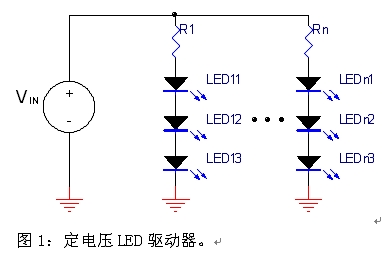With the advent of high-power LEDs, the lighting industry is also facing new challenges. The service life of LEDs and power conversion efficiency have become the main considerations when designing LED lighting systems. In order to provide a constant current to maintain the consistency of LED color and brightness, the constant current LED driver can be used as a switching converter that provides a constant current output. In addition, power-saving or high-efficiency power conversion requirements are an indispensable element in LED lighting applications, and Hysteretic PFM technology can significantly improve power conversion efficiency at light or heavy loads. This article will explore how to design a high-efficiency, high-stability LED lighting system using a constant current LED driver.
Traditional LED Driver: Constant Voltage Mode
The current flowing through the LED determines the brightness of the LED. The higher the current, the brighter the brightness of the LED. In general, the use of a constant voltage or constant current driver can achieve the purpose of lighting the LED. Figure 1 shows the simplest constant voltage LED driver. The current through the LED is controlled by the resistor in series with the LED. For example, if the input voltage is 5V and the forward bias of the LED is 3.6V, then under this condition, if the required LED current is 20mA, the current limiting resistor to be used is 70Ω. Although the architecture of this method is very simple, the LED current will change with the voltage falling across the LED. If the LED forward bias is inconsistent or the input voltage changes slightly, it will affect the brightness of the LED. In addition, the power loss on the current limiting resistor also causes problems of overheating and inefficiency.

Traditional LED Driver: Constant Current Mode
Another commonly used LED driver is a constant current mode driver as shown in FIG. In Figure 2, the current of the LED is provided by a linear regulator whose current can be set by the R1 resistor. Compared to constant voltage mode drivers, constant current mode drivers can control the current flowing through the LEDs without being affected by the LED forward bias and input voltage. However, if the voltage difference between the input voltage and the total forward bias of the LED is too large, there will still be a problem of overheating on the driver.
